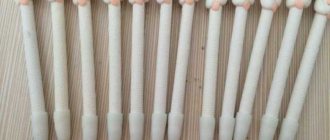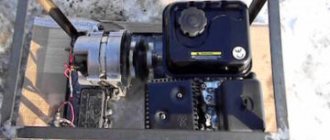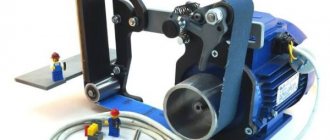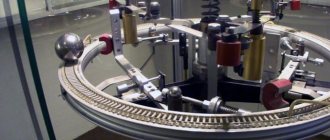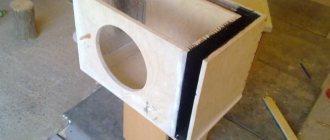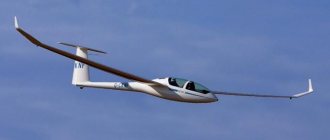The process of converting into a generator
The sequence of actions is as follows:
- The rotor is removed after removing the cover;
- The same stator windings remain; rewinding is not carried out;
- In order for it to become prefabricated, as opposed to its original solid state, it must be ground down to a predetermined size;
- A steel cup five millimeters thick is pressed onto the rotor;
- One of the most difficult operations is marking, which is carried out in order to glue the magnetic elements to the rotor according to the template. The dimension is individually selected for each engine unit;
- Magnetic elements made of neodymium are glued with superglue and additionally reinforced with a nylon filament mesh;
- Everything is wrapped with tape and formwork is carried out to seal it, and then filled with epoxy;
- Flowing down, the resin hardens, after which the tape must be removed;
- The rotor is driven into the generator part with all precautions so that the rotor “stands up” and does not “fly” into the stator due to the force of the magnets;
- The structure is assembled and closed with a lid;
- The functionality is checked using a drill.
Stirling motor from a tin can
To make it, you will need available materials: a can of canned food, a small piece of foam rubber, a CD, two bolts and paper clips.
DIY electronics in a Chinese store.
Foam rubber is one of the most common materials used in the manufacture of Stirling motors. The engine displacer is made from it. We cut out a circle from a piece of our foam rubber, make its diameter two millimeters less than the inner diameter of the can, and its height a little more than half of it.
We drill a hole in the center of the cover into which we will then insert the connecting rod. To ensure smooth movement of the connecting rod, we make a spiral from a paper clip and solder it to the cover.
We pierce the foam circle of foam rubber in the middle with a screw and secure it with a washer at the top and at the bottom with a washer and nut. After this, we attach a piece of paper clip by soldering, having first straightened it.
Now we stick the displacer into the hole made in advance in the lid and hermetically solder the lid and the jar together. We make a small loop at the end of the paperclip, and drill another hole in the lid, but a little larger than the first.
We make a cylinder from tin using soldering.
We attach the finished cylinder to the can using a soldering iron, so that there are no gaps left at the soldering site.
We make a crankshaft from a paper clip. The knee spacing should be 90 degrees. The knee that will be above the cylinder in height is 1-2 mm larger than the other.
We use paper clips to make stands for the shaft. We make a membrane. To do this, we put a plastic film on the cylinder, push it inward a little and secure it to the cylinder with thread.
We make the connecting rod that will need to be attached to the membrane from a paper clip and insert it into a piece of rubber. The length of the connecting rod must be made such that at the bottom dead center of the shaft the membrane is pulled inside the cylinder, and at the highest, on the contrary, it is extended. We set up the second connecting rod in the same way.
We glue the connecting rod with rubber to the membrane, and attach the other one to the displacer.
We use a soldering iron to attach the paper clip legs to the can and attach the flywheel to the crank. For example, you can use an CD.
Stirling engine made at home. Now all that remains is to bring heat under the jar - light a candle. And after a few seconds give a push to the flywheel.
Nuances of the rewinding process
Asynchronous operation of the motor allows it to maintain a constant frequency at which the rotor part rotates, even under different loads. If we talk about the principle of rewinding electric motors, then it is common in terms of execution technology. But individual nuances may vary.
It is best to take a failed device to a workshop, but in some cases it turns out that it is preferable to rewind the engine at home. Only on the condition that you still have certain skills in this matter, despite the relative ease of the process.
For engines there are two types of winding:
- Rotor part;
- Stator.
Taking into account the differences in the size of devices and their design, you can use generalized instructions for rewinding with visual photographs and a descriptive part.
Basic provisions of the instructions
Once a breakdown is detected, the engine must initially be removed from the device.
Further work is carried out in the following sequence:
- The wire parameters and the total number of turns of the coil are determined during the inspection of the motor part;
- The most intact section of the winding fragment is cleaned;
- Carbon deposits are removed using a solvent or firing;
- The protruding upper part of the installation is cut off with an appropriate tool, depending on the cross-sectional area of the wire. Then it is decomposed into separate wires in order to be able to find out the number of turns;
- All detected irregularities on the surface of the iron where the winding was wound must be completely cleaned to make the surface smooth. Otherwise, a new breakout will not be long in coming;
- The cross-section of the new wire must be identical to the old one or as close as possible to it;
- A template is made from cardboard corresponding to the size of the iron on which the winding is carried out. When winding, a special machine is used.
Rules for recycling old batteries
Collection points for old batteries are being organized in cities, where exactly you can find out from the Internet
You should not throw away used power supplies with the rest of the trash; this pollutes the environment. Batteries consist of the following elements:
- steel shell:
- manganese oxide;
- electrolyte;
- zinc;
- graphite;
- paper and plastic.
The release of harmful substances begins after the metal casing rusts. Chemicals penetrate into the upper layers of the soil and, together with precipitation, enter groundwater. Together with them, dangerous compounds end up in the seas and rivers.
A safety threshold has been established for the content of chemical elements in water, air and soil. Exceeding the standards means that being on the territory is dangerous for human and animal health.
For these reasons, a battery recycling system has been developed. Product elements are used in various fields: metallurgy, production of pencils and fertilizers. After recycling, only 5% of the total weight of the battery must be recycled.
The only plant in Russia that recycles power supplies is located in Chelyabinsk. All collected batteries are delivered to this plant for recycling. The city has a developed metallurgical industry, so the resulting metal is used in local factories.
Why do you need a soft start?
Smooth starting of an electric motor makes it possible to reduce the noticeable shortcomings of electric machines.
Besides:
- Repair costs are reduced, since any starting current always overheats the winding, thereby reducing the overall service life of the machine;
- There are practically no jerks, which has a good effect on reducing the wear of gears in transmission mechanisms, as well as the possibility of water hammer in the network when supplying fluid;
- Electrical energy consumption is greatly reduced, since direct starting requires a considerable amount of electrical energy. You need to know that the possibility of voltage sags in cases of power limitation in the network can negatively affect each of the connected devices;
- The overall cost of switching equipment is significantly reduced. Technical electrical devices for drives with an asynchronous operating principle are selected with a sufficient power reserve. The presence of a smooth descent makes it possible to connect more budget protection and switching devices.
The presence of acceleration after a soft start contributes to a significant expansion of the applied scope of asynchronous electric motors.
How to make toys from plastic bottles
DIY snake toys
Make funny foam snakes with this simple device at home!
- Scissors.
- Plastic water bottles.
- Old towels.
- Rubber strip.
- Small bowl.
- Dishwashing liquid.
Cut off the bottom of the plastic bottle.
Secure the towel to the bottom of the bottle with a rubber band.
Place the bottle, towel side down, into the bowl of soapy water. After this, you can create snakes from tiny bubbles.
Care must be taken to prevent soapy liquid from entering the mouth and eyes.
DIY crocodile toy
- Two half-liter plastic bottles.
- Bottle caps.
- Knife.
- Scissors.
- Glue.
- Thin paper.
- Brush.
- Waxed paper.
- Eyes (for example, you can use buttons).
Using a knife and scissors, cut the bottles in half, then trim one piece so that the height remains 7cm.
Trim the edges of the bottles so that the crocodile is bent.
Glue the lid legs to the crocodile evenly.
Make thick paper balls and attach them like crocodile eyes.
Cover the entire body with thin green paper.
Cut out initialed paper and glue on paws, eyes and teeth. Paint your teeth white and your nostrils and eyes black.
Carrying out the armature winding
To wind the armature of an electric motor, a copper wire with a large cross-section is required. An option is used with a non-insulated wire with a rectangular cross-section and an insulated wire with a round cross-section.
In the first case, the wire is intended for power starters with the ability to carry currents of six hundred Amperes or more.
- Insulated wire is used when winding low power starters.
- The winding is single-turn, consisting of a certain number of conductors.
- They are laid in loops in the core. One loop - one turn. A bandage on both sides of the exits beyond the core secures parts of the winding.
Photo of a homemade electric motor
Share with friends



